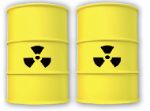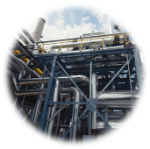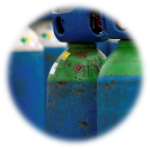________________________________________
Industrial Liaison Group:
Tel: +44 (0) 1235 778797
E-mail: [email protected]

Uranium (U) metal, attached to Magnox cladding and removed from spent fuel prior to reprocessing, is a key component of the UK’s intermediate level waste (ILW). It is encapsulated in grout and sealed within stainless steel canisters in preparation for interim storage and eventual disposal. Understanding corrosion processes that may occur in these U-containing waste canisters is critical to ensuring the safe long term containment of this ILW (>100 years).
Read more...
One key problem facing the nuclear industry is how to store spent nuclear fuel safely in the long term. Any deep geological repository will be built to last many thousands of years, and there is the very real potential that the stored spent fuel will come into contact with groundwater. The predominant component of nuclear fuel is uranium dioxide (UO2), which is insoluble in water. However, the residual radioactivity of the fission daughter products, and of the fuel itself, cause the radiolytic splitting of water into highly oxidising species. These products then cause the dissolution of the fuel with the subsequent release of fission products into the environment.
Read more...
Lung surfactant proteins are essential proteins found in the surfactant layer at the air-water interface of the lung. They provide the first line of defence for the body when exposed to ozone, present as a secondary pollutant in ambient air. It is known that ozone exposure can cause respiratory distress and can lead to increased hospital admissions and even death. The actual mechanism by which ozone disrupts the respiratory system is not well understood.
Read more...
The “freezing” of diesel fuel in winter has been a problem since its inception. Wax crystals nucleate and grow and block fuel lines and filters which can lead to vehicle failures and motorists being stranded. Additives are used to control these crystals but, over recent years, the use of biofuels (fatty acid methyl esters) within diesel blends has become increasingly common. This can adversely affect the low temperature operability of the fuel. Legislation demands that biofuels are part of diesel blends throughout the EU, with levels expected to increase.
Read more...
Drug products are manufactured to an extremely high standard to maintain product safety when taken by patients. Specifications used throughout the manufacturing process cover not only the drug itself, but also the level of potential impurities (chemical, solvent, or polymorph), which are set to limits that are monitored by regulatory bodies to uphold safety and product quality requirements. X-ray powder diffraction is a key analytical technique in the pharmaceutical industry for characterising drug compounds. This is used for throughout the development process to fingerprint compounds and quantify impurities.
Read more...
”Corrosion resistant” metals are used in challenging environments and where safety is critical, such as in pipelines, aircraft and nuclear waste storage vessels. But it is precisely these materials that are vulnerable to a form of corrosion known as pitting. Understanding of the mechanisms by which these pits form and propagate may allow engineers to build more accurate models of corrosion to predict the lifetime of components and plan when they need inspecting or replacing.
Read more...
Using current technologies, it is possible to store and transport hydrogen as a liquid at very low temperatures, or a gas under very high pressure, but both of these have serious implications for weight, cost and safety. Metal-organic frameworks (MOFs) are extended molecular structures constructed from metal cations linked by organic molecules. They have recently shown considerable promise in a wide range of applications, including hydrogen storage, catalysis and drug delivery.
Read more...Conducting polymers such as poly(aniline) (PANI) have shown great potential for application in flexible electronic devices. They represent an opportunity to utilise low cost, large scale manufacturing processes compared those required to produce inorganic semiconducting materials. However, such polymer based semiconductors suffer structural defects, which significantly limit the conductivity achievable.
Read more...
In theory, sufficient energy reaches the earth’s surface from the sun to meet all of our foreseeable energy needs in a sustainable manner. In practice, the best currently available technology for converting solar energy into electricity – the silicon photovoltaic cell - is very expensive and intrinsically difficult to manufacture on a large scale. Organic based photovoltaics (OPV) that can be manufactured using environmentally friendly materials in low temperature, low cost continuous processes could make a significant contribution to total energy demands.
Read more...Diamond Light Source is the UK's national synchrotron science facility, located at the Harwell Science and Innovation Campus in Oxfordshire.
Copyright © 2022 Diamond Light Source
Diamond Light Source Ltd
Diamond House
Harwell Science & Innovation Campus
Didcot
Oxfordshire
OX11 0DE
Diamond Light Source® and the Diamond logo are registered trademarks of Diamond Light Source Ltd
Registered in England and Wales at Diamond House, Harwell Science and Innovation Campus, Didcot, Oxfordshire, OX11 0DE, United Kingdom. Company number: 4375679. VAT number: 287 461 957. Economic Operators Registration and Identification (EORI) number: GB287461957003.